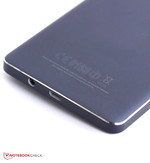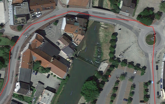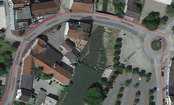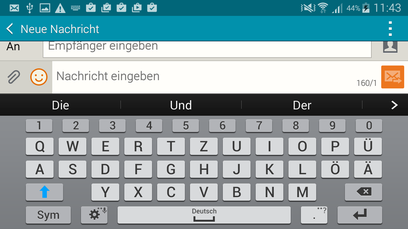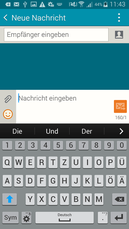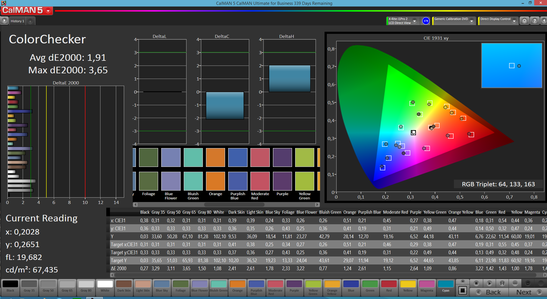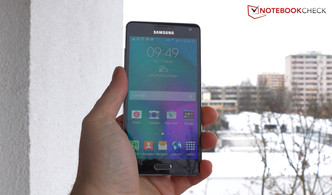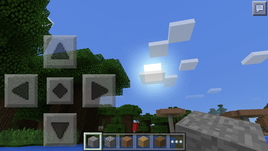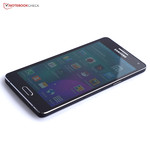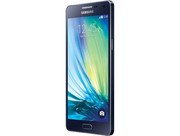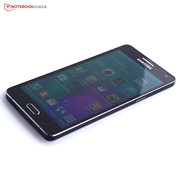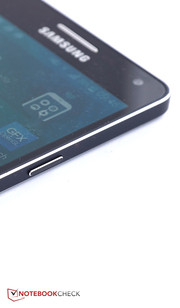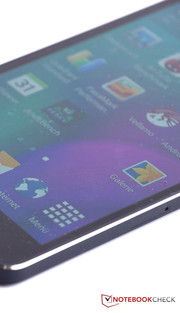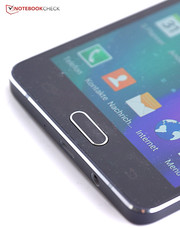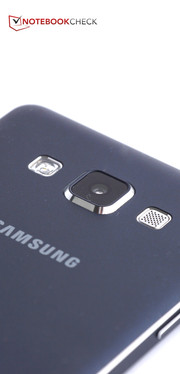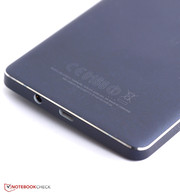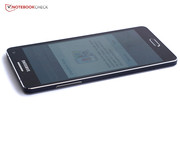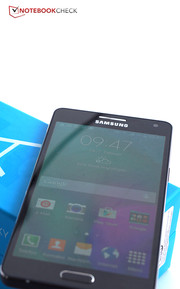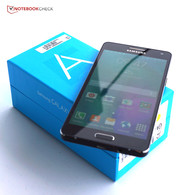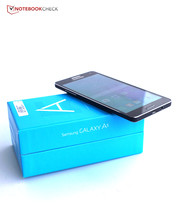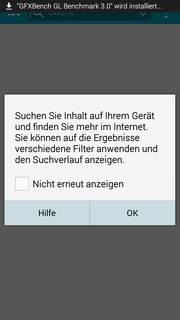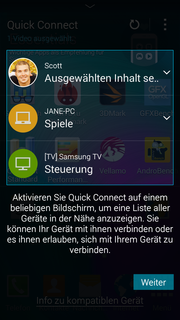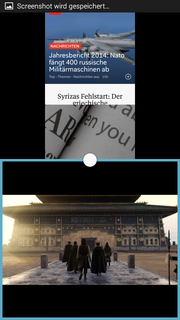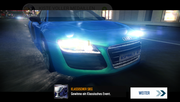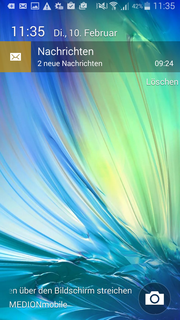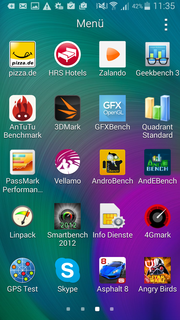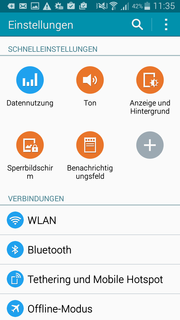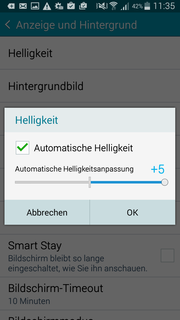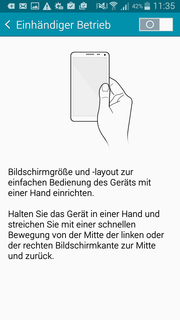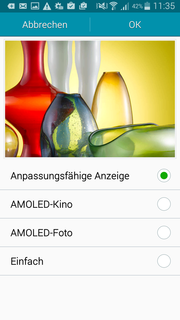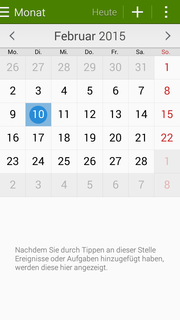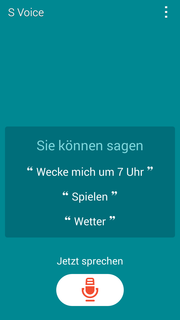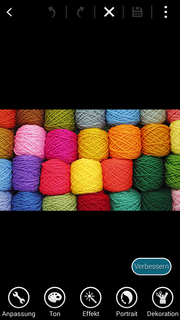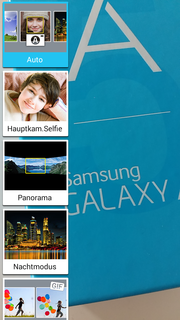Samsung Galaxy A5 Smartphone Review

For the original German review, see here.
It immediately becomes obvious that everything is different about Samsung's Galaxy A5 the first time it's picked up: a unibody metal casing, restrained design, non-removable back cover. Samsung wants to improve quality, particularly since customers have not been buying as many of the Korean smartphones as usual lately. After the Galaxy Alpha marked the start of the metal era at Samsung, two mid-range models with an aluminum unibody have been released in the market: the somewhat smaller Galaxy A3 and the Galaxy A5 that we are testing here.
There are, however, even more manufacturers in the mid-range, for example HTC with its Desire 510. The One E8 and Sony's Xperia Z3 Compact are not much more expensive, either. Huawei's Ascend G7, Nokia's Lumia 830, Asus' Zenfone 5 and Sony's Xperia T3 are also contenders from this price range. Of course, Google's long running Nexus 5 is still in the market.
Case
At first glance, the Galaxy A5 looks very high-quality and stylish, and it has a less obtrusive design than former Galaxy models. Leather textures, curved lines, and elaborate designs seem a thing of the past; a more serious yet very elegant sobriety now prevails.
The casing is also extremely thin with a height of just 6.7 millimeters. It is even slimmer than the latest iPhone 6. Nevertheless, the casing's stiffness is very satisfactory. The device at most creaks quietly under high pressure, barely warps, and it does not pass pressure applied on the front and back to the screen. The quality impression is high owing to the unibody, non-slip rear, and the components' flush gaps.
White, black, gold and silver colors are available in Germany and Austria. The more eccentric pink and light blue colors are reserved for other markets.
However, a typical characteristic of Galaxy smartphones has been cut due to the slim build. The battery in the Galaxy A5 is no longer removable. The nano-SIM and micro-SD card are in trays on the side, which can be opened with a special SIM tool or another small, thin object.
Connectivity
Until now, only a few mid-range devices supported NFC, the standard for near field communication. LTE has become standard even in the mid-range now. With 16 GB, Samsung's Galaxy A5 has a slightly higher storage capacity than some other mid-range models. The screen resolution of our review sample is also in line with the category level, although Google's Nexus 5, for example, has Full HD. The Galaxy A5 makes an overall well-equipped impression, but it is also considerably more expensive than other mid-range smartphones.
Software
Samsung's TouchWiz interface is still based on Android 4.4.4. However, now that even older devices like the Galaxy Note 2 and Galaxy S4 are being updated to Android 5, buyers of current Samsung phones from the mid and premium ranges should not worry too much. It is also possible to work well with the latest TouchWiz version. The desktop is clearly arranged and will not puzzle users switching from other Android phones.
The user will find a so-called "briefing" from Flipboard when scrolling to the far left on the home screen. Flipboard is a preloaded news aggregator that can also link social media updates from the user's profiles. Many smartphone builders offer this now, and it is also quite handy although its features are a bit sparse. For example, we would like to delete news that has been read.
Samsung wants to restrain itself with preloaded apps in future. Instead, the "Galaxy Essentials" widget that provides tips for more or less useful downloads from the App store is installed. Voice control "S Voice," the calendar "S Planner" and the image editor "Studio" are still preloaded. Although the user will have to accept a few adware apps, longer pressure on the icon allows uninstalling them quickly.
Communication & GPS
The Galaxy A5 supports six LTE bands and achieves speeds of up to 150 Mbit per second in downstream and up to 50 Mbit per second in upstream, owing to LTE Cat. 4. Four frequencies are available in the GSM and UMTS networks. We mostly had good signal strength in the poorly developed German E-Plus net in an urban area.
The fastest available Wi-Fi standard is 802.11 n, which at least enables network speeds of up to 300 Mbit per second. The signal strength was decent. We still had three-quarters of the signal ten meters away from the router and through three walls. Websites opened very fast. The signal dropped to half another two meters and an additional wall between the device and router, and websites opened a bit slower.
NFC is installed just like Bluetooth 4.0 and ANT+. The latter is a standard that aims to improve the communication among other devices like gym machines, remotes, home electronics, and smartphones.
The GPS module located us with an accuracy of three meters outdoors. Localization was not possible indoors. The module also supports the Russian Glonass and Chinese BeiDuo networks.
A car trip provides more detailed data about accuracy. We took both Garmin's Edge 500 navigation system and Samsung's Galaxy A5. There was a deviation of not quite 150 meters between both navigation systems at the end of our roughly 37-kilometer route. In fact, the differences in tracking accuracy in difficult sections, such as crossing a bridge or in the woods, were relatively low between both devices. Samsung's Galaxy A5 was a bit more off-route in the woods than Garmin's device. However, the Galaxy A5 is well-suitable for navigation.
Telephone & Voice Quality
The phone app will be familiar to Samsung veterans, but it should not puzzle newcomers too much, either. Four tabs at the top of the screen open the keypad, the call log that, for example displays missed calls, the contacts and favorites determined by the user. The keypad's design is quite plain and provides big keys. However, it can only be used in portrait mode. Additionally, multiple settings allow rejecting calls from specified contacts directly, ending calls automatically by pressing the standby button, and many more options.
Unfortunately, the voice quality is not completely convincing. Though sound is quite loud in maximum volume, it is not always clear and hums sometimes. The sound is more balanced as soon as the volume is reduced, but it is by far not as rich and clear as, for example, in Sony's Xperia Z3 Compact. The sound that our caller hears is much worse. The microphone in the Galaxy A5 occasionally clicks and does not register our voice when we are a bit further away from the microphone. At least the background noise suppression functioned quite well.
Cameras & Multimedia
Samsung's Galaxy A5 has better camera equipment than most mid-range phones in the comparison. At least the data on the spec sheet suggests that. The rear-facing camera has a resolution of 13 megapixels, an auto-focus and LED flash, and it records Full HD videos with 30 frames per second. The front sports a 5-megapixel camera with special features for selfies.
The pictures shot with the rear-facing camera are still sharp when zoomed. However, the exposure is not quite as accurate and the focus is a bit more blurry when compared directly with pictures taken with the iPhone 6. The feature "Rear-cam Selfie mode" enables taking sharp self-portraits even with the primary camera; the camera automatically focuses on detected faces. The image is either shot automatically via the self-timer or when volume up is pressed on the rocker. Although this feature works, our experience is that the face's sharpness is not always correct. Good selfies are also possible with the 5-megapixel front-facing camera, though they look a bit grainy.
Accessories
A power supply, USB cord and a headset are in the box. The latter conveys a good sound and is also quite suitable for hands-free mode. An S View Cover in white or charcoal black that enables accessing some functions, such as taking pictures, via a plastic window on the front is also optionally available for around 40 Euros (~$45). A protective cover that envelops the device like a frame and protects it against shocks is sold for 20 Euros (~$22).
Samsung includes a 24-month warranty on the smartphone itself. The battery and accessories are only repaired free of charge for six months. Naturally, this does not affect the implied warranty.
Input Devices & Controls
The virtual keyboard provides many options and input methods. However, its keys are also a bit small. The keys' generous spacing compensates for that and typing is thus relatively accurate. Voice dictation or swiping over the keyboard are just as possible as switching quickly between different keyboard language layouts and dictionaries by holding down the space bar for a longer time. The keyboard's lettering is very basic and clear despite the multiple features.
The touchscreen responded absolutely reliably and fast to our inputs. It is sensitive into its corners. Besides that, multi-touch gestures were almost always identified and implemented correctly.
The volume rocker on the casing's left and the standby button on the right have a high-quality feel, and they both feature a good pressure point. A physical home button that functions properly and two touch buttons that also always responded directly to our inputs are below the screen.
Display
The Super AMOLED screens by Samsung are known for their great color reproduction and absolute black because the organic light-emitting diodes simply do not light up in black areas. The screen in the Galaxy A5 has a resolution of 1280x720 pixels and achieves a high maximum brightness of 482 cd/m². As to illumination, the darkest area of a homogeneously colored surface is only 85% as bright as the brightest area. That is an average rate; we did not see a brightness difference on large, white surfaces with only our eyes.
| |||||||||||||||||||||||||
Brightness Distribution: 85 %
Center on Battery: 482 cd/m²
Contrast: ∞:1 (Black: 0 cd/m²)
ΔE ColorChecker Calman: 2.15 | ∀{0.5-29.43 Ø4.78}
ΔE Greyscale Calman: 1.81 | ∀{0.09-98 Ø5}
Gamma: 2.42
CCT: 6626 K
| Samsung Galaxy A5 Adreno 306, 410 MSM8916, 16 GB eMMC Flash | HTC Desire 510 Adreno 306, 410 MSM8916, 8 GB SSD | Sony Xperia Z3 Compact Adreno 330, 801 MSM8974AC, 16 GB eMMC Flash | Huawei Ascend G7 Adreno 306, 410 MSM8916, 16 GB eMMC Flash | Nokia Lumia 830 Adreno 305, 400 MSM8926, 16 GB eMMC Flash | Asus Zenfone 5 Adreno 305, 400 MSM8926, 8 GB eMMC Flash | Sony Xperia T3 Adreno 305, 400 MSM8928, 8 GB SSD | Google Nexus 5 Adreno 330, 800 MSM8974, 16 GB iNAND Flash | |
|---|---|---|---|---|---|---|---|---|
| Screen | -245% | -142% | -80% | -15% | -39% | -83% | 8% | |
| Brightness middle (cd/m²) | 482 | 355 -26% | 513 6% | 446 -7% | 440 -9% | 389 -19% | 521 8% | 469 -3% |
| Brightness (cd/m²) | 432 | 371 -14% | 500 16% | 451 4% | 421 -3% | 375 -13% | 504 17% | 452 5% |
| Brightness Distribution (%) | 85 | 80 -6% | 94 11% | 91 7% | 87 2% | 88 4% | 89 5% | 94 11% |
| Black Level * (cd/m²) | 0.37 | 0.41 | 0.73 | 0.77 | 0.58 | 0.77 | 0.49 | |
| Colorchecker dE 2000 * | 2.15 | 12.13 -464% | 8.54 -297% | 5.72 -166% | 2.6 -21% | 4.22 -96% | 5.73 -167% | 2.05 5% |
| Greyscale dE 2000 * | 1.81 | 14.77 -716% | 9.88 -446% | 6.16 -240% | 2.64 -46% | 3.08 -70% | 6.83 -277% | 1.45 20% |
| Gamma | 2.42 91% | 2.42 91% | 3.03 73% | 2.19 100% | 2.32 95% | 2.57 86% | 3.46 64% | 2 110% |
| CCT | 6626 98% | 17097 38% | 8659 75% | 7699 84% | 6686 97% | 6840 95% | 8370 78% | 6441 101% |
| Contrast (:1) | 959 | 1251 | 611 | 571 | 671 | 677 | 957 |
* ... smaller is better
Large, black surfaces on the screen look absolutely dark. Since the AMOLED screen can completely deactivate the diodes and because there is no backlight, the black level is 0.0 cd/m². The theoretical contrast ratio is thus infinite, and colors make a very vivid impression due to the high contrast. Samsung again installs different screen modes that can be set individually in the menu. Colors look a bit paler but more natural in "Standard," they are more emphasized in "Photo," and the colors are very bright in "Movie." The screen can also automatically select the matching screen mode according to the opened application.
We check just how accurate the color reproduction is with a photospectrometer and CalMAN software. The sRGB color space is used as the reference unless we note otherwise. Again, "Standard" mode displays the most accurate colors. The colors are very close to the reference color space value. "Movie" is the exact opposite, and the naked eye can see that the colors are oversaturated and that bright hues have an evident violet cast. Thus, users who want an as accurate color reproduction as possible should select "Standard" mode because the screen provides a very good color reproduction here. However, it will unlikely be exact enough for professional users. Finally, we look at the "Photo" mode in the AdobeRGB color space comparison. We are very satisfied with the marginal color shift here.
The surface reflects to such an extent in direct sunlight that virtually nothing can be recognized on the screen. However, content becomes legible again when the smartphone is tilted the slightest bit. It is then possible to work well with the device as long as the text is not too small. The high brightness and theoretically infinite contrast make it easy to recognize something on the screen in bright surroundings. Indoor use or the shade are no problem from the outset.
Performance
All mid-range devices used for comparison are based on Qualcomm Snapdragon SoCs that usually come from the 400 line. Only Google's Nexus 5, Sony's Xperia Z3 Compact and HTC's One E8 sport the faster 800 or 801 SoCs from Qualcomm.
Our review sample is furnished with a Qualcomm Snapdragon 410 MSM8916 with 1.2 GHz and four cores. That could certainly have been more when that is put in relation with the fairly high price of Samsung's Galaxy A5.
It is possible to work swiftly with the operating system in practice. The multi-window function can also be used easily and without lags when running a YouTube video and the image gallery simultaneously. Slow-downs cannot always be prevented in more sophisticated applications, but that is likely due to the graphics card. The processor in the SoC operates with its full speed in any case. The Galaxy A5 is on par or even faster than its mid-range rivals, but it is clearly slower than high-end devices in Geekbench.
| Smartbench 2012 - Productivity Index (sort by value) | |
| Samsung Galaxy A5 | |
| HTC Desire 510 | |
| Sony Xperia Z3 Compact | |
| Asus Zenfone 5 | |
| Sony Xperia T3 | |
| Google Nexus 5 | |
The Galaxy A5 stands out in Internet browsing. It is the fastest device among the mid-range contenders in many benchmarks and is only clearly surpassed by high-end devices. Thus, even more demanding web applications, such as videos and animations, should not be a problem.
| Sunspider - 1.0 Total Score (sort by value) | |
| Samsung Galaxy A5 | |
| HTC Desire 510 | |
| HTC One E8 | |
| Sony Xperia Z3 Compact | |
| Huawei Ascend G7 | |
| Nokia Lumia 830 | |
| Asus Zenfone 5 | |
| Sony Xperia T3 | |
| Google Nexus 5 | |
| Google Nexus 5 | |
| Octane V2 - Total Score (sort by value) | |
| Samsung Galaxy A5 | |
| HTC Desire 510 | |
| HTC One E8 | |
| Sony Xperia Z3 Compact | |
| Huawei Ascend G7 | |
| Asus Zenfone 5 | |
| Sony Xperia T3 | |
| Google Nexus 5 | |
| Google Nexus 5 | |
| Mozilla Kraken 1.1 - Total (sort by value) | |
| Samsung Galaxy A5 | |
| HTC Desire 510 | |
| HTC One E8 | |
| Sony Xperia Z3 Compact | |
| Huawei Ascend G7 | |
| Nokia Lumia 830 | |
| Asus Zenfone 5 | |
| Sony Xperia T3 | |
| Google Nexus 5 | |
| Google V8 Ver. 7 - Google V8 Ver. 7 Score (sort by value) | |
| Samsung Galaxy A5 | |
| HTC Desire 510 | |
| Sony Xperia Z3 Compact | |
| Nokia Lumia 830 | |
| Asus Zenfone 5 | |
| Google Nexus 5 | |
* ... smaller is better
The graphics performance of the Adreno 306 with a clock of 450 MHz lags behind devices based on the same SoC in 3DMark, but the scores are again proper in GFXbench. Thus, we do not presume bigger problems. Stutters cannot always be avoided in very sophisticated graphics calculations in real-world usage. Nevertheless, the graphics card's power should be enough for most games in the Play Store.
| 3DMark | |
| 1280x720 offscreen Ice Storm Unlimited Score (sort by value) | |
| Samsung Galaxy A5 | |
| HTC Desire 510 | |
| HTC One E8 | |
| Sony Xperia Z3 Compact | |
| Huawei Ascend G7 | |
| Asus Zenfone 5 | |
| Sony Xperia T3 | |
| Google Nexus 5 | |
| 1280x720 offscreen Ice Storm Unlimited Graphics Score (sort by value) | |
| Samsung Galaxy A5 | |
| HTC Desire 510 | |
| HTC One E8 | |
| Sony Xperia Z3 Compact | |
| Huawei Ascend G7 | |
| Asus Zenfone 5 | |
| Sony Xperia T3 | |
| Google Nexus 5 | |
| 1280x720 offscreen Ice Storm Unlimited Physics (sort by value) | |
| Samsung Galaxy A5 | |
| HTC Desire 510 | |
| HTC One E8 | |
| Sony Xperia Z3 Compact | |
| Huawei Ascend G7 | |
| Asus Zenfone 5 | |
| Sony Xperia T3 | |
| Google Nexus 5 | |
| GFXBench (DX / GLBenchmark) 2.7 | |
| T-Rex Onscreen (sort by value) | |
| Samsung Galaxy A5 | |
| HTC One E8 | |
| Sony Xperia Z3 Compact | |
| Huawei Ascend G7 | |
| Nokia Lumia 830 | |
| Google Nexus 5 | |
| 1920x1080 T-Rex Offscreen (sort by value) | |
| Samsung Galaxy A5 | |
| HTC One E8 | |
| Sony Xperia Z3 Compact | |
| Huawei Ascend G7 | |
| Nokia Lumia 830 | |
| Google Nexus 5 | |
| GFXBench 3.0 | |
| on screen Manhattan Onscreen OGL (sort by value) | |
| Samsung Galaxy A5 | |
| HTC Desire 510 | |
| HTC One E8 | |
| Sony Xperia Z3 Compact | |
| Huawei Ascend G7 | |
| Asus Zenfone 5 | |
| Sony Xperia T3 | |
| 1920x1080 1080p Manhattan Offscreen (sort by value) | |
| Samsung Galaxy A5 | |
| HTC Desire 510 | |
| HTC One E8 | |
| Sony Xperia Z3 Compact | |
| Huawei Ascend G7 | |
| Asus Zenfone 5 | |
| Sony Xperia T3 | |
Samsung has always stood out with very high speeds in storage, and the Galaxy A5 can also outperform many of the comparison devices. Even the high-end devices can only keep up in the read speeds; the Galaxy A5's write rates are clearly higher than those of all other devices.
Games
The Galaxy A5 proves to be an average mid-range device in games. Though most games in Google's Play Store can be played, titles with high graphics requirements will not satisfy users who value an absolutely smooth gameplay and high frame rates. For example, Asphalt 8: Airborne can be played in high details, but it is very visible even for the naked eye that the frame rates are very close to the limits of micro-stutters. However, simpler games like Angry Birds: Star Wars 2 will run absolutely smoothly.
The precise control via touchscreen and position sensor is pleasing. They never let us down in any situation.
Emissions
Temperature
The casing's temperatures are not really worth mentioning. The maximum temperature that we measured in full load was 31.4 °C. It is barely lower with 29.2 °C in idle mode. Thus, only very sensitive users will likely notice a change in the temperature during load. The temperature development is therefore very good.
Only the question whether the performance relevant components can maintain their full power even after a longer period of high load remains open. We tested that with the battery test of GFXBench, which runs the same test 30 times in succession and records the frame rates. It is obvious that the components are throttled when the fps drop at some time. This is not the case in the Galaxy A5 - the performance remains stable.
(+) The maximum temperature on the upper side is 31.4 °C / 89 F, compared to the average of 35.2 °C / 95 F, ranging from 21.9 to 247 °C for the class Smartphone.
(+) The bottom heats up to a maximum of 31.3 °C / 88 F, compared to the average of 34 °C / 93 F
(+) In idle usage, the average temperature for the upper side is 27.7 °C / 82 F, compared to the device average of 32.9 °C / 91 F.
Speakers
One Samsung Galaxy tradition has not changed - the speaker is on the rear of the Galaxy A5. The drawback of this is that the sound distorts extremely when the smartphone is on a table. It even muffles clearly when it is placed on a soft surface. The sound is well balanced in maximum volume when the smartphone is held in the hand. However, it lacks the final hint of power and richness. In any case, the speaker is more suitable for an occasional music clip or conversations than for clashing movie effects. When preferred, a speaker can be connected either via Bluetooth or the 3.5 mm combo-audio jack. That is recommendable; both methods allow an impeccable sound.
Energy Management
Power Consumption
The power consumption of the Galaxy A5 makes a mixed impression. The minimum requirement in the idle scenario (features like Wi-Fi and Bluetooth off, minimum brightness, no load) is quite high with 0.8 watts. Then again, the other idle consumption rates are quite satisfactory, although Google's Nexus 5 clearly undercuts them.
The average load consumption (maximum screen brightness, all additional functions on) is relatively low with 1.9 watts. It can climb up to 4 watts under absolute maximum load. Other mid-range smartphones, such as Nokia's Lumia 830 and Asus' Zenfone 5, consume less here.
The "Ultra Power Saving" mode can be activated should the battery be low on-the-move. It switches the screen to black and white and disables all unnecessary background processes. Besides that, only specified apps can be accessed. The user easily gains a few more hours of battery power, for example when waiting for a call.
| Off / Standby | |
| Idle | |
| Load |
|
Key:
min: | |
Battery Runtime
The removable battery is often a make or break factor among Samsung Galaxy disciples. The battery life can factually be doubled by carrying around a second, charged battery. This is, unfortunately, no longer possible with the Galaxy A5 because the battery is not removable. The battery has a capacity of 8.7 watt hours, which is not bad within the comparison field. Only the premium range model Xperia Z3 Compact or the 0.5-inch bigger Huawei Ascend G7 have more.
Overall, the runtime is quite similar with those of the other mid-range smartphones in the comparison. However, Samsung's Galaxy A5 particularly shows a weakness in a real-world category: it did not even manage 9 hours when browsing via Wi-Fi. All smartphones manage at least a slightly longer runtime. Nokia's Lumia 830 even achieved over 12 hours. The Galaxy A5 easily lasts a day in mixed use including standby. The smartphone has to be first recharged every second day when it is used frugally.
| Samsung Galaxy A5 Adreno 306, 410 MSM8916, 16 GB eMMC Flash | HTC Desire 510 Adreno 306, 410 MSM8916, 8 GB SSD | Sony Xperia Z3 Compact Adreno 330, 801 MSM8974AC, 16 GB eMMC Flash | Nokia Lumia 830 Adreno 305, 400 MSM8926, 16 GB eMMC Flash | Sony Xperia T3 Adreno 305, 400 MSM8928, 8 GB SSD | Google Nexus 5 Adreno 330, 800 MSM8974, 16 GB iNAND Flash | |
|---|---|---|---|---|---|---|
| Battery runtime | 9% | 99% | 15% | -10% | 4% | |
| Reader / Idle (h) | 19.2 | 21.3 11% | 43.6 127% | 30.1 57% | 19.5 2% | 18.5 -4% |
| H.264 (h) | 10 | 24.6 146% | 9.6 -4% | |||
| WiFi (h) | 8.9 | 9.5 7% | 22.1 148% | 12 35% | 10.6 19% | 12.2 37% |
| Load (h) | 4 | 4.4 10% | 2.9 -27% | 2.9 -27% | 2 -50% | 3.1 -22% |
Verdict
The Galaxy A5 is not exactly cheap, but the buyer gets a round total package. The stylish, slim and very rigid casing sets standards in the mid-range, the camera configuration is generous, and the input devices are pleasingly accurate. Besides that, it sports a superb screen, useful battery runtimes, and the user does not have to worry about increased casing temperatures.
However, there are still some wishes open: A Full HD would have rounded off the image on the screen, a swifter SoC would have justified the price more, and Samsung could improve the quality of both the microphone and speaker.
The buyer overall gets a high-priced but also high-quality mid-range smartphone with Samsung's Galaxy A5, though.




